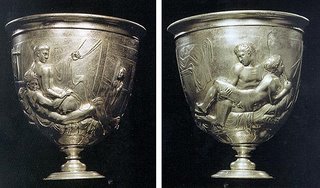Pervy Pottery

To the British Museum to see the 'Warren Cup'. I walked from Holborn through the backstreets of Bloomsbury, past Howard Hodgkin's house and Atlantis the Occult bookshop in Museum Street (ghosts of Yeats and Crowley). I like Bloomsbury best on overcast Autumn afternoons. It puts me in mind of secret societies, and conversations about magic in dark sitting rooms with ticking clocks and candlelight. When I first met Peter Ackroyd we arranged to meet outside the Museum gates on such an afternoon. At the time I was obsessed with the 'House of Doctor Dee' and spent entire afternoons in the backstreets of Clerkenwell looking for it. When I told Peter this he said 'oh you silly cow it's all a fiction darling you should know that' and of course I did... but I like the idea of blurring fiction and fact. I often forget which is which.
Anyway... Luckily I didn't have to fight my way through too many Sunday afternoon tourists as the cup in just inside the doors in an antechamber. The cup is Roman, but depicts Greek figures, and was probably made in the first century AD by Greek craftsman for a Roman client. It's made of silver and I thought it would be massive, more of an urn than a cup, but it's only 11cms high. It's in a glass case and spotlit from below casting strong shadows.
On both sides are male couples. The first side depicts a bearded older man with a smooth muscular youth lowering himself down with the help of a sort of ceiling strap (bet you can't get those in Clone Zone) whilst a boyservant peeps at them from behind a curtain.
On the other side the older seemingly dominant partner is himself a youth and his 'Beloved' (as they were called) is younger still. In fact, very young.
The first owner of recent times was the American Anglophile Ned Warren, the commissoner of Rodin's 'The Kiss'; thereafter the cup was in a private collection. The British Museum paid £1.8 million for the cup six years ago. It was offered to them half a century ago at a fraction of that price but as the signage guiltily admits because of the climate of the time the object was rejected by the trustees as it would have been impossible to display without risking a huge public outcry.
The room is small, and the cup is center-stage. I expected to find a small crowd of Shocked-of-Tunbridge-Wells types pursing their lips around it but in fact all of life was there and very interested and fascinated everyone looked too... although a number of teenage boys were a bit wide-eyed it has to be said.
The cup is padded out by other examples of early AD sexual depiction on pottery, plates and assorted knick-knacks including some very athletic women with women and even (gasp!) some heterosexuals.
My favourite thing was a large green flying phallus (yes, with wings) with various smaller dicks attached and hung with bells. I asked in the shop for a replica but they don't have one, but quite what you'd do with it I have no idea. I suppose it could be a sexy windchime... I should think it added a sort of frisson to Roman swinging parties and maybe they rang it when it was time to change ends and/or partners.
The first older partnership shown looks at least nearly-legal in a modern context and makes one think that perhaps the Greeks weren't 'all that bad' but then I can't help thinking that the focus of this side of the cup is actually on the boy peeping through the curtain rather than on the partnered figures.
We know now that at that time there was no word to describe homosexuality. Men did not live together and same-sex relationships were not recognised socially, so I was interested that the museum have also hung contemporary visuals of chaps together.
This appears at first glance to be an apt context I can't help thinking that the cup has little to do with gayness by and large, or at least gayness as we we understand it.
"The Warren Cup: Sex and Society in Ancient Greece and Rome" is on until early July


<< Home